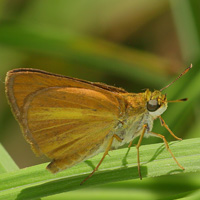Dukes’ Skipper
Scientific name: Euphyes dukesi

Photo credit: Allen Woodliffe
Status
Special Concern
“Special Concern” means the species lives in the wild in Ontario, is not endangered or threatened, but may become threatened or endangered due to a combination of biological characteristics and identified threats.
Date added to the Species at Risk in Ontario List
January 29, 2024
Read the assessment report (PDF)
What it looks like
Dukes’ Skipper is a small butterfly (wingspan of 31 to 37 mm) with rounded wing edges. Males have sooty-black wings with occasional orange along the edge of the front wings and centre of the hind wings.
Females are dark brown, sometimes with orange spots in the centre of the forewing. Both males and females have an orange-brown underside and a pale orange-yellow streak running through the centre of the hindwing.
Where it lives
The range of Dukes’ Skipper extends from southwestern Ontario through Michigan and northern Indiana and Ohio, south to eastern Texas and eastward to Florida.
Dukes’ Skipper lives in hardwood swamps with natural clearings or edges containing large patches of sedges (grass-like plants).
Females lay eggs under the leaves of sedge plants and the caterpillars feed on the flowers and seedpod. In Ontario, these host plants are reported to be Lake Sedge (Carex lacustris) and Shoreline Sedge (Carex hyalinolepis).
In the late summer, the caterpillar prepares for overwintering by attaching itself with silk to the upper portion of the plant. In early spring, the caterpillar continues to feed before transforming into a butterfly.
Adult butterflies will travel into open spaces in search of nectar plants, which in Ontario can include:
- Swamp Milkweed (Asclepias incarnata)
- Common Milkweed (Asclepias syriaca)
- Thistles (Cirsium)
- Spreading Dogbane (Apocynum androsaemifolium)
- Dense Blazing Star (Liatris spicata)
- Virginia Mountain Mint (Pycnanthemum virginianum)
- Cup Plant (Silphium perfoliatum)
Where it’s been found in Ontario
Dukes’ Skipper is found in the following areas of southwestern Ontario:
- Municipality of Chatham-Kent
- County of Essex
- County of Lambton
What threatens it
In Ontario, the greatest threat to Dukes’ Skipper is the rapid spread of invasive Phragmites (European Common Reed). Phragmites can take over Dukes’ Skipper habitat and reduce available food.
Other lower impact threats that have been observed to or have the potential to impact the Dukes’ Skipper habitat are:
- activities related to land development
- agricultural practices
- water level fluctuations
Action we are taking
While special concern species and their habitat do not receive protection under the Endangered Species Act, 2007, the act requires us to prepare recovery guidance for special concern species, unless a recovery strategy or management plan is required for the species under the federal Species at Risk Act.
All species listed on the Species at Risk in Ontario List may be eligible for consideration for government funding through the Species at Risk Stewardship Program.
What you can do
Report a sighting
Submit your observations of species at risk to the Natural Heritage Information Centre (NHIC), which is Ontario’s conservation data centre. Join the “(NHIC) Rare Species of Ontario” project in iNaturalist to make submitting your observations quick and easy.
Volunteer
Volunteer with species at risk programs, such as community science surveys, through your local nature club, a provincial park or other conservation organizations.
Be a good steward
- Private landowners have a very important role to play in species recovery. If you find species at risk on your land, you may be eligible for stewardship programs that support the protection and recovery of species at risk and their habitats. Learn more about the Species at Risk Stewardship Program.
- Invasive species seriously threaten many of Ontario’s species at risk. To learn what you can do to help reduce the threat of invasive species, visit:
- As with all wildlife, be respectful and observe from a distance.
Report illegal activity
Report any illegal activity related to species at risk to
Quick facts
- Dukes’ Skipper does not migrate. Members of the species carry out their lifecycle within a 1.5 km area of where the egg was laid.
- Adults live about 2-3 weeks and the total lifespan from hatching is about a year.
- The species was first named in 1923 by Arthur Ward Lindsey, an American entomologist.
- Adults will travel into open spaces in search of nectar plants, which in Ontario can include Swamp Milkweed, Common Milkweed, thistles, Common Dogbane, Dense Blazing Star, Virginia Mountain Mint and Cup Plant.
- Other invasive and non-native wetland plant species, such as Purple Loosestrife, may also be threatening Dukes’ Skipper habitat by restricting waterflow through wetlands.